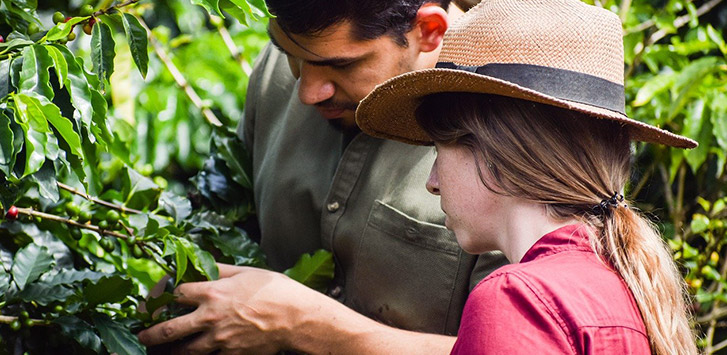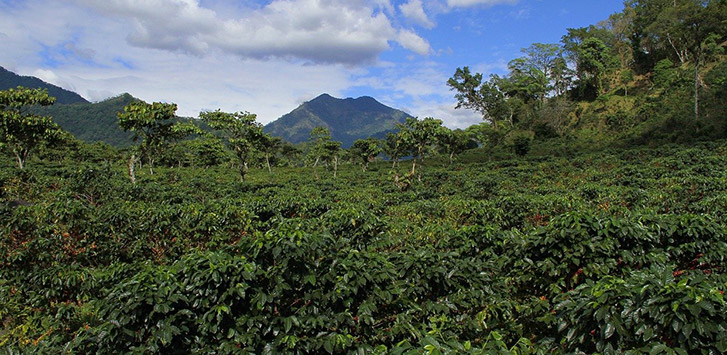
Guatemala is considered the jewel of the Central American coffee industry. Serving mainly Arabica coffee beans, of the typica and bourbon variety, Guatemala boasts the perfect climate to grow world-class coffee beans. Guatemalan coffee beans produce a high-quality cup of coffee that is full-bodied, strong, and sweet with gentle acidity and complex flavors unique to each of the eight growing regions.
Early Coffee History
In the mid-1700s, Guatemalans saw coffee plants as solely ornamental. That changed after the Guatemalan economy took a hit when its main industry of natural dye was taken over by the arrival of synthetic dye. In the 1860s, Guatemala started to focus on coffee production to boost its economy. As the coffee industry grew, coffee farmers developed their union, called Anacafé, which dealt with marketing, research, and financial support for the farmers.
Modern Coffee Production

Guatemala is one of the top ten largest coffee producers in the world. The coffee industry depends entirely on the seasonal influx of migrant workers from around Guatemala to each of the seven coffee-producing regions. Currently, there are around 130,000 coffee farms in the country.
Since Guatemala has such a humid climate, its’ coffee beans usually are washed, or wet-processed. The high humidity disrupts the natural, dry processing of coffee beans, making natural processing a less reliable method. Wet-processing is more consistent and highlights the beans’ natural acidity through an extended fermentation period of one to two days.
Through the years, Anacafé has created and branded eight growing regions with the motto “A Rainbow of Choices”, representing the diversity of flavors and growing climates presented by these eight growing regions.
Growing Conditions & Regions
Guatemala boasts one of the most diverse climates in the world with eight main growing regions. Antigua, Huehuetenango, and Atitlan are the three most popular regions. While many of the coffee farms are located at 5,000ft., the farms’ altitudes range from 1,600ft. to 16,400ft. The high altitude creates a more robust coffee beans flavor.
Guatemala has a mild, subtropical climate with a long-wet season and high elevations. The main growing regions (Antigua, Acatenango, Atitlan, Coban, Huehuetenango, Fraijanes Plateau, San Marcos, and Nuevo Oriente) all produce nuanced coffee bean flavors, due to the differences in elevation, soil quality, rainfall, and sunlight exposure.
Elevation – The higher the elevation, the higher the coffee bean quality. Higher altitudes often have harsher growing conditions, exposing the coffee plants to more extreme weather. Harsher winds, colder temperatures, heavier rainfall, and more sunlight exposure force the coffee plants to fight to survive. While it is harder for the plants to grow, elevation ultimately cultivates great coffee beans, as the extra nutrients produced to keep the plants alive lend a depth and richness of flavor to the beans.
Soil Quality – Most of the eight growing regions are located on or near volcanic soil. Volcanic soil is best for growing coffee plants. It is full of nutrients – such as phosphorus, potassium, and calcium – that add flavor to the coffee beans.
Rainfall – The perfect amount of rainfall is around 59-78 inches for 8 to 10 months per year. Guatemala gets around an average of 30-60 inches of rainfall per year, depending on the region. The high elevations allow for the rainfall to reach the coffee plants better.
Sunlight – Coffee plants need an average of bright sunlight and indirect sunlight for 2 hours per day. The high elevation aides in this.
Growing Regions’ Climates

NUEVO ORIENTE
The Nuevo Oriente region is made up of small towns and local farmers. It is located near a former volcanic range, leaving the soil full of metamorphic rock and nutrients. For much of the year, Nuevo Oriente is rainy and cloudy with a dense, moist atmosphere.
FRAIJANES PLATEAU
The Fraijanes Plateau is at a high elevation, as the name suggests. This region sees heavy rainfall and is located near another volcanic region. Much of the volcanic ash has found its way into the Fraijanes Plateau’s soil, providing it with extra minerals and vitamins to help the coffee plants thrive.
SAN MARCOS
San Marcos is the warmest growing region with the highest amount of rainfall. Due to the rains, the coffee plants’ flowering is earlier than in other regions. The farmers in San Marcos pre-dry the coffee in the sun and then machine dry it, due to the unpredictability of the rainy season.
ANTIGUA
Antigua is in the southern highlands of Guatemala near three active volcanoes. It is one of the most well-known growing regions in Guatemala with low humidity, lots of sunlight, and cool evening temperatures. The beans grown in Antigua have a crisp, apple-like acidity with sweet floral notes and a deep chocolate flavor.
HUEHUETENANGO
Huehuetenango is in the northern highlands. It is the highest coffee growing region in the country. Abundant rivers and streams around the region saturate the soil, nourishing the coffee plants.
ACATENANGO VALLEY
The Acatenango Valley is located slightly southwest of Antigua. It is a dense, shady area near Fuego Volcano. The soil is full of nutrients and minerals from eruptions over the years.
ATITLAN
Atitlan is a volcanic region in southwestern Guatemala. It is located near Lake Atitlan, where the coffee beans benefit from both the rich volcanic soil and the surrounding lake.
COBAN
Coban is a subtropical rainforest with a gentle rainfall of 129-157 inches for 8 to 10 months a year, prolonging the flowering of the coffee crops due to constant rainfall. It is considered the most fertile region.
Taste & Flavor Profile
Each growing region produces a coffee bean with a slightly different flavor profile. Usually, the coffee is medium to full-bodied with chocolate flavor notes, either bittersweet cocoa or sweet milk chocolate, depending on the region.
The coffee also has notes of nuts and toffee and is known to be sweet with a smoky aftertaste. Generally, due to the high elevation, the beans have a bright, pleasant acidity. Some of the higher elevation beans have brighter notes of berries, green apple, and citrus.
Here are three flavor profiles of three different growing regions:
HUEHUETENANGO
Huehuetenango coffee provides some different varieties. One variety, Huehuetenango SHB, has light acidity with caramel and fruity flavors. It also boasts notes of maple, orange, and milk chocolate with a syrupy body.
An organic blend is the Guatemala Organic HHT FTO, which is both fair trade and organic certified. It has bright acidity with a well-balanced body. Chocolaty flavors intertwine with nutty, fruity, and flowery notes.
ANTIGUA
Antiguan coffee beans have a vibrant acidity with a velvety, smooth, full-bodied texture. Sweet, chocolatey notes dominate the blend, mixed in with orange and lemon flavors.
SAN MARCOS
San Marcos produces nutrient-rich coffee beans, boasting a low acidity, full flavor, and full body. The silky-smooth cup has floral and nutty flavors throughout.
Ways to Brew
Guatemalan coffee has bright acidity, natural sweetness, and subtle flavors that are best captured with immersion brewing methods.
French Press – Due to the constant contact with hot water, the natural sweetness and unique flavors are evenly extracted from the beans. If you use a French Press, try a dark roast. Be careful not to over-extract the coffee, as you will end up with a bitter cup.
Pour Over – If you are going to use a pour-over method, use a fine ground, medium roast, and a paper filter to get a clean cup with bright, clear flavor notes. Pour over is great with a Guatemalan bean because it produces a rich, full-bodied cup of coffee while highlighting the subtle fruity and floral notes.
Cold Brew – Cold Brew highlights the lighter acidity and sweetness of the beans, due to its long steep time. The final cup of coffee is full-bodied with heavy sweetness and medium acidity.
Conclusion
Guatemala boasts one of the best climates for growing coffee plants. The resulting, single-origin coffee beans produce a full-bodied, pleasantly acidic, richly flavored cup of coffee. The best brewing methods for Guatemalan coffee, to ensure that you get all the flavor and acidity in your cup of coffee, are immersion methods. If you want to take it one step further, you can always learn how to roast your Guatemalan coffee beans, too.